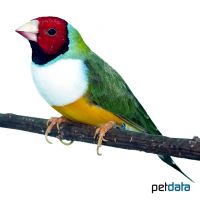Red-headed White-breasted Gouldian Finch (Chloebia gouldiae)
| Red-headed White-breasted Gouldian Finch Chloebia gouldiae | |
|---|---|
| Name | Red-headed White-breasted Gouldian Finch |
| Name Lat. | Chloebia gouldiae |
| Family | Estrildid Finches |
| Family lat. | Estrildidae |
| Order | Perching Birds |
| Order lat. | Passeriformes |
| Origin | Australia |
| Climate | Tropical |
| Diet | Finch seed, plant matter, insects |
| Keeping | Pair, group |
| Care Level | Moderate |
| Reproduction | Finch nest |
| Life Span | 5-10 years |
| Protection | No |
| Metric Units | |
| Size | 14 cm |
| Temperature | Room temperature |
| Housing | 120 x 50 x 50 cm |
| US Units | |
| Size | 5.5" |
| Temperature | Room temperature |
| Housing | 45" x 20" x 20" |
Distribution and habitat
Gouldamadins are native to the hottest areas of northern Australia. They live in the eucalyptus savannahs and semi-deserts, where they always stay near waterholes and pools. Since the export ban in 1960 they are only available as offspring in many color mutations. The Goulda dragon "Red-headed white" is a color breeding.
Cage size
The minimum cage size is 120 x 50 x 50 cm (L x W x H) for a pair. The cage size must not be undercut even in case of justified single keeping. For an additional 2-3 birds, assuming species compatibility, the floor space must be increased by 25%. The cage must be placed in a bright, draught-free and quiet place at a height of at least 80 cm (except aviaries), have a rectangular base and be opaque on three sides, aviaries on one side. Keeping in an aviary is preferable.
Maintenance
The floor must be covered with sand, wood granulate, bark mulch or similar material and must be cleaned regularly. At least 3 perches made of wood or branches of varying thickness and height must be installed in such a way that they can only be reached by flying and that the longest possible flight distance is created. They need a bathing opportunity as well as biotope-like hiding, sleeping and nesting possibilities. It is recommended to provide them with grasses, twigs and bushes. The room temperature must not fall below 18 °C.
Diet
The species-specific feed offer consists of mixed seeds, available in specialized trade as "exotic feed" in premium quality, supplemented with red foxtail millet, green feed (chickweed, green panicle millet, fresh grass panicles, organic lettuce etc.), insect feed and especially for the rearing of young swollen or germinated seeds (millet, oats), egg feed, egg millet and insect larvae (e.g., oats).), insect food and, especially for raising young, swollen or germinated seeds (millet, oats), egg food, egg millet and insect larvae (e.g., skinned, cut meal beetle larvae, ant pupae, small buffalos) and charcoal, vitamin lime and shell grit as digestive aids. If there are several birds, several feeding stations should also be set up. Drinking water must always be available in birdbaths or in stable, open containers and, like food, must be offered fresh daily in clean containers. A varied diet promotes good health.
Reproduction and breeding
Males as well as females occur black-, red- and yellow-headed in nature, the breast shield is purple, the belly yellow. Females are colored the same, but the purple of the breastplate and the yellow of the abdomen is much paler, the head color is less bright or duller.
They like to breed in biotope-like facilities such as large basket nests (bionesters) and semi-open larger nest boxes. Suitable nesting materials include coconut fiber, sisal, longer grasses, and feathers. The clutch consists of 5-6 eggs, the incubation period is about 14 days. The breeding season is, biologically speaking, year-round. During breeding and moulting the room temperature should be at least 22 °C.
The average life expectancy is 5-10 years.
Important
They must not be kept in a round cage. An aviary is required for flock keeping
In the case of outdoor aviary keeping, they also require a heated shelter with a floor area of at least 1 m² and a height of 1.70 m, which can be visited by the birds at any time. The temperature in the shelter must not fall below 18 °C and the furnishings must correspond to those of cage keeping.
They may only be kept in pairs or in a group or flock. Socialization with other finches is possible. In rooms, including shelters, sufficient daylight or flicker-free artificial light (stroboscopic effect) corresponding to daylight must be provided. The lighting duration shall be 8-14 hours per day and the natural day-night rhythm shall be observed. Adequate indoor climate shall be provided. The health condition of the birds shall be checked daily
Further literature can be found in your pet store.
References
Text: petdata; Image: petdata
Source: BMELV (1995): Tierschutzgutachten - Mindestanforderungen an die Haltung von Kleinvögeln; BIELFELD (1996): Das Prachtfinken-Buch, Verlag Eugen Ulmer; GRUMMT & STREHLOW (2009): Zootierhaltung - Tiere in menschlicher Obhut: Vögel, Verlag Harri Deutsch
- Gemäß § 21 Abs. 5 Tierschutzgesetz idgF
